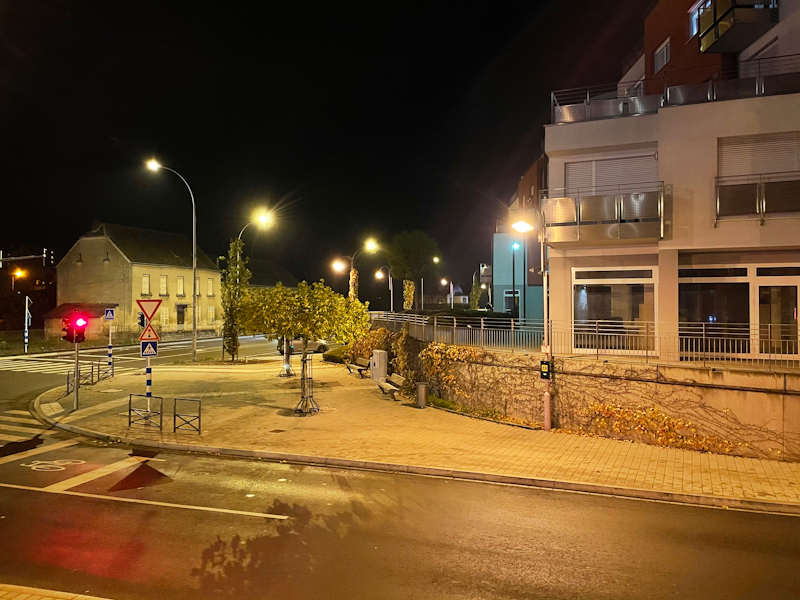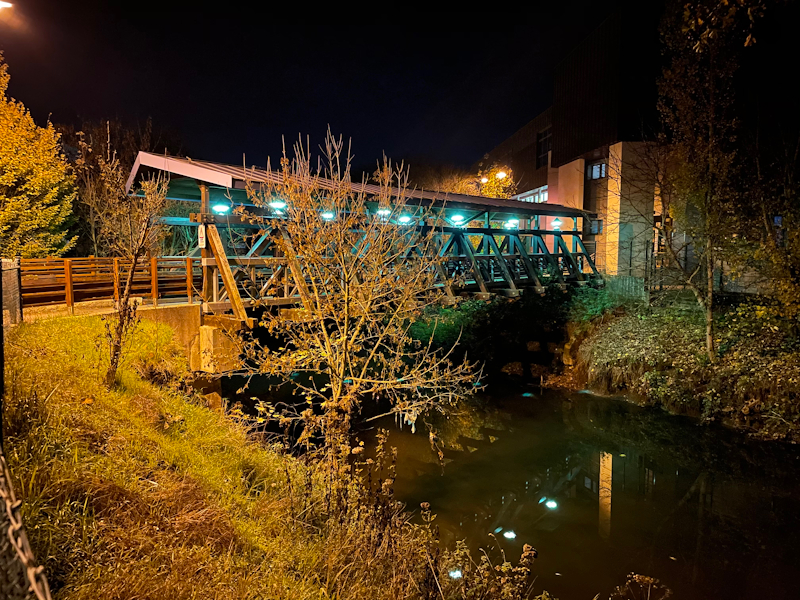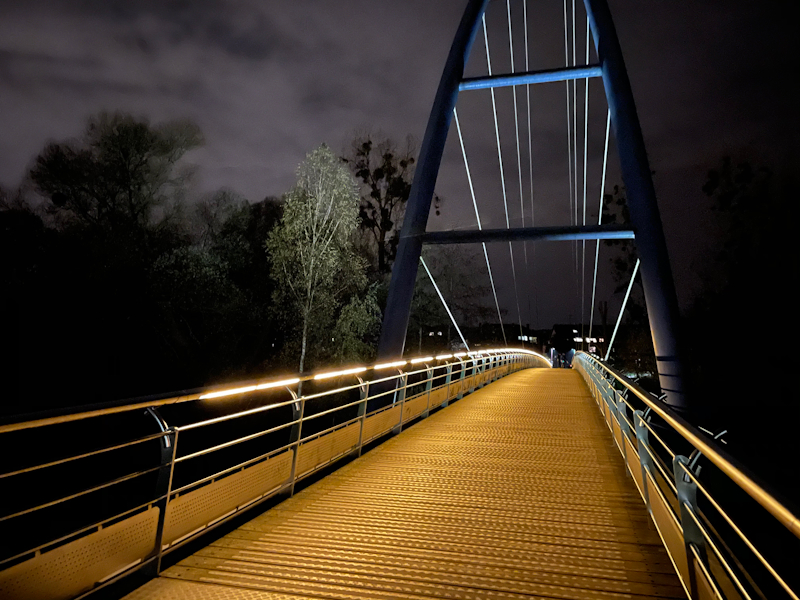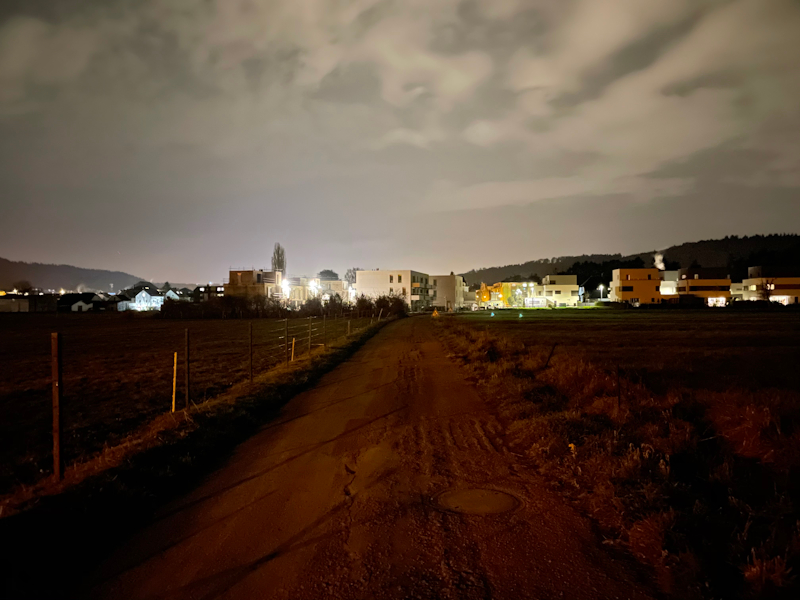The iPhone 12 & 12 Pro Review: New Design and Diminishing Returns
by Andrei Frumusanu on November 30, 2020 8:30 AM EST- Posted in
- Mobile
- Apple
- Smartphones
- Apple A14
- iPhone 12
- iPhone 12 Pro
Camera - Low Light Evaluation
Low-light capture on the iPhone 12’s should be improved for two reasons: First of all, the new f/1.6 lens of the main camera should allow for 27% better light capture compared to the f/1.8 unit of the iPhone 11’s. Secondly, Apple with this generation has finally addressed the lack of Night Mode on the ultra-wide and telephoto modules, resolving a quite huge handicap that was present on the iPhone 11 generation of devices.

[ iPhone 12 Pro ]
[ iPhone 11 Pro ]
[ Note20 Ultra (S) ]
[ S20+ (E) ]
[ Pixel 5 ] [ X-T30 ]
In this first scene, the results are actually a bit disappointing as we’re seeing almost no differences between the 12 Pro and the 11 Pro. The new phone uses half the exposure time according to the EXIF data, but has to use a higher ISO level to compensate. The only thing that’s noticeably better on the 12 Pro is the improved lens flare produced by the street light.
In general Apple’s Night Mode still doesn’t look to be as competitive as Google’s or Samsung’s implementation, as the S20, Note20 Ultra and the Pixel 5 perform quite better here.
On the ultra-wide angle, the inclusion of Night Mode now turns this camera module from something unusable to rather passable results. It’s a huge upgrade compared to the iPhone 11 series, but still lags behind the Pixel phone as far behind Samsung’s implementation.

[ iPhone 12 Pro ]
[ iPhone 11 Pro ]
[ Note20 Ultra (S) ]
[ S20+ (E) ]
[ Pixel 5 ] [ X-T30 ]
Night mode being fully automatically triggered on the iPhone’s camera, means there’s no way to force it on when there’s too much light, such as in this scene – which is really odd given that it did trigger on the iPhone 11 Pro, thus producing an overall better result than the 12 Pro.
The UWA again gains massive usability with the addition of Night Mode, although all the phones here produce quite bad results for a variety of different reasons.

[ iPhone 12 Pro ]
[ iPhone 11 Pro ]
[ Note20 Ultra (S) ]
[ S20+ (E) ]
[ Pixel 5 ] [ X-T30 ]
Here, the 12 Pro uses the larger aperture optics to reduce the ISO from 800 to 640. There’s a slight change in colours, but overall I wouldn’t say that it’s something that would be immediately noticeable between the two generation of phones.

[ iPhone 12 Pro ]
[ iPhone 11 Pro ]
[ Note20 Ultra (S) ]
[ S20+ (E) ]
[ Pixel 5 ] [ X-T30 ]
This scene was a bit odd for the two iPhones as they both showcased identical exposure times as well as ISO levels, although the iPhone 12 Pro shot is brighter due to the larger aperture. The phone didn’t trigger Night Mode for this shot as it was too bright.
Night Mode for the UWA is a large jump for the iPhone 12, but it can’t compete against the Samsung devices or the Pixel phone, although the latter got the colour temperature completely wrong.

[ iPhone 12 Pro ] [ iPhone 11 Pro ]
[ Note20 Ultra (S) ] [ S20+ (E) ]
[ Pixel 5 ] [ X-T30 ]
Here again the iPhone 12 Pro uses the larger aperture in order to reduce the ISO levels of the shot, which is a bit odd given that I feel that the iPhone 11 Pro had the sharper and less noisy shot. There’s also a change in colour temperature although saying which is better is subjective.

[ iPhone 12 Pro ] [ iPhone 11 Pro ]
[ Note20 Ultra (S) ] [ S20+ (E) ]
[ Pixel 5 ] [ X-T30 ]
Finally, in an extreme low-light shot I’m simply challenging the light capture abilities of the cameras here. This scene was extremely dark and the first sample shot of the Fuji is likely better representation of the scene as experienced in-person, while the EV+2 shot is closer to the exposure the phones are trying to achieve.
Neither of the phones are faring well here, and the iPhone 12 Pro does change a bit of the tone-mapping compared to the iPhone 11 Pro, faring a bit better, although I feel the Samsung phones are producing a more natural look.
Low-Light Conclusion: Improved, but not Competitive
In general, I feel that Apple may have overpromised a bit on the part of the low-light capture ability of these new phones. While we do notice the larger aperture optics of the new modules in the resulting captures, Apple doesn’t seem to have substantially changed their Night Mode processing this year as sometimes it’s very hard to distinguish the iPhone 12 from the iPhone 11 results.
On the ultra-wide angle, the new Night Mode options obviously transforms previously unusable results into something that’s more passable. I feel that this shouldn’t be taken as praise versus Apple finally addressing a huge feature lack in the iPhone 11 series, as they were the only devices on the market actually lacking this functionality on the ultra-wide modules.
Although the results have improved, Apple here still largely lags behind the competition which sports better hardware, and also has been able to iterate on their computational photography modes over the past year.
It’s a pity that Apple chose to only employ a larger improved camera sensor on the iPhone 12 Pro Max, creating model differentiation on the cameras that previously didn’t exist – I would have had at least wished the 12 Pro to also house this improved sensor, if possible.










101 Comments
View All Comments
mrvco - Monday, November 30, 2020 - link
It was a good run since the OG iPhone launched, but I seem to have lost all interest in replacing smart phones. I've been using an XS Max (~work phone) and an LG V40 (~personal phone) for two years now and I'm still perfectly satisfied with both devices. They both do what I ask of them with little fuss and there just haven't been any new features or phones that have generated more than a passing interest for me.Bob Todd - Monday, November 30, 2020 - link
As someone who would sometimes change phones more than once a year, I've been in a similar place. We are getting to the point of "good enough" performance. Faster is always better, but high end (and even midrange) SOCs are pretty good these days. My 2 year old phone has 8GB of RAM, 256GB of storage, and a nice large display.I do think this generation of iPhones is interesting for a few reasons though. The Mini doesn't even have a good analogue in the Android world, and I'm excited that premium smaller form factor phones are a thing again.
FunBunny2 - Monday, November 30, 2020 - link
"The Mini doesn't even have a good analogue in the Android world, and I'm excited that premium smaller form factor phones are a thing again."it depends on use case. for those who use a smartphone mostly as a phone, then these Godzilla handsets are contraindicated. OTOH, if the use case is mostly watching video on the run, then the Max and similar make the most sense. Steve clearly intended the former, Mr. Market gave him a full body enema by telling him to shove those teeny, tiny thingees.
KPOM - Monday, November 30, 2020 - link
My mother and sister both opted for the 12 mini since they got tired of big phones. I’m sure they aren’t alone.GC2:CS - Monday, November 30, 2020 - link
Well is there any reason why LPDDR5 was not used over the entire lineup (including M1) ? Is there some hidden compromise with LPDDR5 ?So if CPU is improved quite a bit in regards to efficiency, why the GPU lacks an update ? Is it possible that newer node benefits the CPU more than GPU ?
I heard about new Pro Oleds having better viewing angles. This is something i would greatly appreciate. 11´s Pro do have quite big shifts in white - at screen edges it has greenish, bluish cast. Can somebody describe it a but more ?
I think this generation could be better. But 5G is quite monumental increse in RF complexity and imagining they did it with custom antena designs and thinner designs is quite remarkable.
For exemple three mmWave antenas were discoverd so far. One on the side next to the battery, one behind the motherboard and one under the notch on the front.
But on the other hand 5G sucked up all the effort for other upgrades like better bigger cameras, batteries, 120 Hz and so on.
I refuse to believe that the next one is iPhone 13. That is just so unlucky...
michael2k - Monday, November 30, 2020 - link
I think you answered your own question. The focus on 5G took resources away from lpddr5.mmm200 - Monday, November 30, 2020 - link
I had both X and Xs Max, wife has 11 Pro.I could tell you how good the new 12 Pro Max display is.
It is better than Apple MBP16 in both color and brightness stability! 2 weeks in I'm amazed still how good the Pro display is!
Don't like the oversaturated images made indoor. Just too much vibrance and saturation. Looks unnatural.
2.5x telephoto is great outdoors in sunny weather.
HDR video capture is mindblowing! Using 1080p30 and 1080p60 - looks great on LG OLED!
name99 - Monday, November 30, 2020 - link
It's quite possible that world LPDD5 production capacity was not yet large enough?My GUESS is that the memory controller can handle LPDD5, and the M1X machines will ship with it (and those will be in low enough volume that it's not an issue).
I was surprised that the M1 Macs did not, but presumably Apple concluded it made no engineering sense -- they are clearly fast enough as is, so why not hold something in reserve to make the M1X machines look even better when they ship?
vFunct - Monday, November 30, 2020 - link
Why do you do camera tests without a SINGLE shot of a human being? You know, because how everyone uses phone cameras to take pictures of people at parties and other social events?Are you unable to find anyone willing to have photos taken?
michael2k - Monday, November 30, 2020 - link
Taking pictures of people aren't actually important for the test scenarios:Daylight evaluation is measuring the sensor and software in their ability to balance contrast, dynamic range, shadows, details, and color (and of course there were some people in those pictures)
Low light evaluation is evaluating how well the software can enhance the image without sacrificing color information, creating unusual color casts, capturing details, and balancing the light and darker portions of the pictures.
What you seem to be asking for is a review of https://www.anandtech.com/show/14892/the-apple-iph...">Portrait Mode? The 2018 https://www.anandtech.com/show/13392/the-iphone-xs...">Portrait Mode review was similarly brief (both less than 5 paragraphs!)